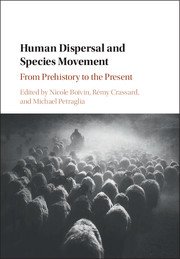Book contents
- Frontmatter
- Contents
- List of text boxes
- List of figures
- List of tables
- List of contributors
- Preface
- I Introduction
- II Origins: Species Movements in the Pleistocene
- III Across the water: Species movements by Coast and Sea
- IV Complexity: Species Movements in the Holocene
- 9 Dispersals, connectivity and indigeneity in Arabian prehistory
- 10 Reconstructing migration trajectories using ancient DNA
- 11 Out of the Fertile Crescent: The dispersal of domestic livestock through Europe and Africa
- 12 Adapting crops, landscapes, and food choices: Patterns in the dispersal of domesticated plants across Eurasia
- 13 Tracing the initial diffusion of maize in North America
- 14 Proto-globalisation and biotic exchange in the Old World
- V Invasion: The Movement of Invasive and Disease Species
- Index
- Plate section
- References
11 - Out of the Fertile Crescent: The dispersal of domestic livestock through Europe and Africa
from IV - Complexity: Species Movements in the Holocene
Published online by Cambridge University Press: 04 May 2017
- Frontmatter
- Contents
- List of text boxes
- List of figures
- List of tables
- List of contributors
- Preface
- I Introduction
- II Origins: Species Movements in the Pleistocene
- III Across the water: Species movements by Coast and Sea
- IV Complexity: Species Movements in the Holocene
- 9 Dispersals, connectivity and indigeneity in Arabian prehistory
- 10 Reconstructing migration trajectories using ancient DNA
- 11 Out of the Fertile Crescent: The dispersal of domestic livestock through Europe and Africa
- 12 Adapting crops, landscapes, and food choices: Patterns in the dispersal of domesticated plants across Eurasia
- 13 Tracing the initial diffusion of maize in North America
- 14 Proto-globalisation and biotic exchange in the Old World
- V Invasion: The Movement of Invasive and Disease Species
- Index
- Plate section
- References
Summary
Abstract
This chapter tracks the dispersal of domestic sheep, goats, pigs, and cattle, from the Fertile Crescent to their points of furthest dispersal in northern Europe and southern Africa. It brings together archaeological and genetic data to illuminate the biological, geographic, and broadly cultural factors that shaped their journeys. Although considered part of a ‘Neolithic package’, these species did not always travel together. Their individual trajectories were moulded both by biological constraints and by the cultural and economic features of their human partners. Mechanisms of dispersal varied. Demic movement and replacement of indigenous foraging strategies was the primary driver of their journeys through Europe, while exchange and incorporation into local economies was more prominent in Africa – though important exceptions in both continents underscore the complexity of the process. Independent domestication outside of the Near East played only a limited role, with the one exception being the introgression of European wild boar into imported stock of Near Eastern swine, and their eventual dominance in the heritage of domestic pigs across both Europe and the Near East.
Keywords: Domestic livestock, demic diffusion, indigenous incorporation, Europe, Africa
INTRODUCTION
The emergence and spread of domesticates and the agricultural economies based upon them had the greatest transformative impact of any mass species movement in human history and, perhaps, in the history of the planet. Domestication created new varieties of plants and animals that, under the protection of humans, could be grown in almost all environments around the world (see also chapters in this volume by Fuller and Lucas, Denham, Larson, and Smith). The impacts of the development of agricultural economies based on domesticates are profound. Agriculture is a principal factor in the loss of global biodiversity, in the transformation of Earth's landforms, and in the alteration of its atmosphere. It fuelled a population explosion of agro-pastoralists and has been a cornerstone of increasingly complex societies around the world. If we are entering a new epoch of the Anthropocene in which humans have become the main drivers of Earth's systems, the origin and global spread of domesticates and agricultural economies surely played major roles in ushering in this brave new world (Smith and Zeder 2013).
- Type
- Chapter
- Information
- Human Dispersal and Species MovementFrom Prehistory to the Present, pp. 261 - 303Publisher: Cambridge University PressPrint publication year: 2017
References
- 30
- Cited by

